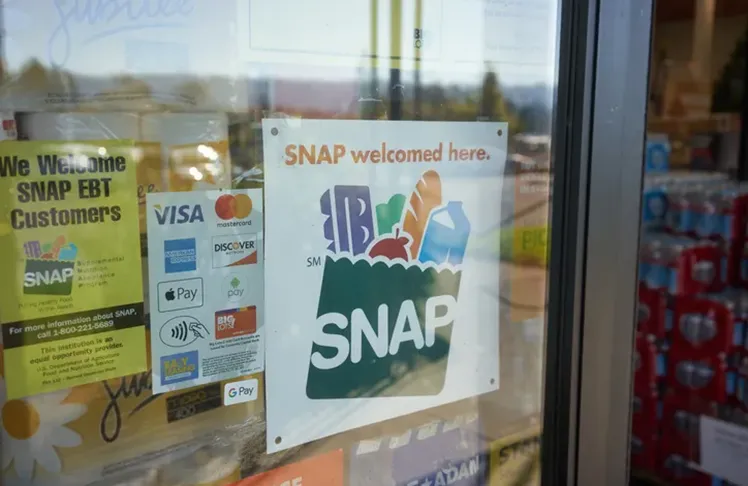
“SNAP welcomed here” sign is seen at the entrance to a Big Lots store in Portland, Oregon. Credit: hapabapa / iStock Editorial / Getty Images Plus
When Congress couldn’t agree on a budget to fund the government before Oct 1, officials used some budget trickery to guarantee that the Supplemental Nutritional Assistance Program, known as SNAP, would continue through the end of the month.
But if Congress doesn’t pass a budget by Nov. 1, millions of people who put food on the table through SNAP — a disproportionate number of whom are Black — may have a lean Thanksgiving.
“Many people in America are a single missed paycheck away from needing support from their local food banks,” Claire Babineaux-Fontenot, CEO of Feeding America, said when the shutdown started on Oct. 1. “A prolonged shutdown will deepen the strain, and more families will seek help at a time when food banks are already stretched due to sustained high need.”
The U.S. Department of Agriculture, which runs SNAP, has advised agencies distributing funds at the state level that they should halt the process that would allow recipients’ EBT cards to be reloaded at the beginning of November. Recipients use the debit cards when grocery shopping.
It’s possible the cards could be reloaded, whether or not the government gets back to full service, but any delay will be a zinger for families.
Who Receives SNAP?
Roughly 42 million people face hunger or food insecurity each month. Of those 25.7% of SNAP participants, roughly 10.2 million people, are Black. Participants receive an average of $187 a month. Studies show the program reduces a family’s chance of being food insecure by almost 30% and helps keep millions of children above the poverty line. SNAP also helps boost local economies and protects recipients’ health.
An overwhelming majority of SNAP participants are families with children, and more than a third are older adults or people with disabilities. Each state has its own process for residents to apply for SNAP benefits. Applicants can find their state’s human services office at USDA’s Food and Nutrition Service.
Who Pays for SNAP?
The federal government pays for SNAP benefits out of tax revenue, and states share the program’s operating costs. Several states, including North Carolina, Missouri, and Pennsylvania, have already announced that SNAP benefit payments will be on hold during November if the shutdown continues.
Emergency Funds for WIC
Earlier this month, the Special Supplemental Nutritional Program for Women, Infants, and Children — also known as WIC, the program that helps more than 6 million low-income pregnant and postpartum women, infants, and children under age 5 buy nutritious food — was about to run out of money in several states. The Trump administration transferred $300 million to WIC to keep it afloat through the end of the month.
“While emergency funds were provided for the month of October, without additional action, families who participate in WIC could experience disruptions in early November,” said Alison Hard of the National WIC Association. “The longer the shutdown continues, the greater the risk to families with infants and young children who rely on WIC for nutritious foods and breastfeeding support.”
The Trump Administration Cut SNAP Benefits
If and when the federal government gets back to business, the Trump administration’s so-called One Big, Beautiful Bill Act will slash SNAP by unprecedented amounts. Some households will see a cut in their benefits — or lose their SNAP eligibility entirely — because the new law shortens the length of time some disabled individuals can receive benefits. Participants will also have to document that they are working or engaging in a “qualified activity” for at least 20 hours each week.
On top of these historic attacks on SNAP, the USDA has approved pilot projects in 12 states to restrict the foods families can purchase with SNAP. The projects range from bans on items, like soda or candy, to sweeping policies like Iowa’s, which prohibits fruit strips, some fruit and nut items, and certain granola bars.
Feeding America also offers a food bank directory that individuals and families can access.















